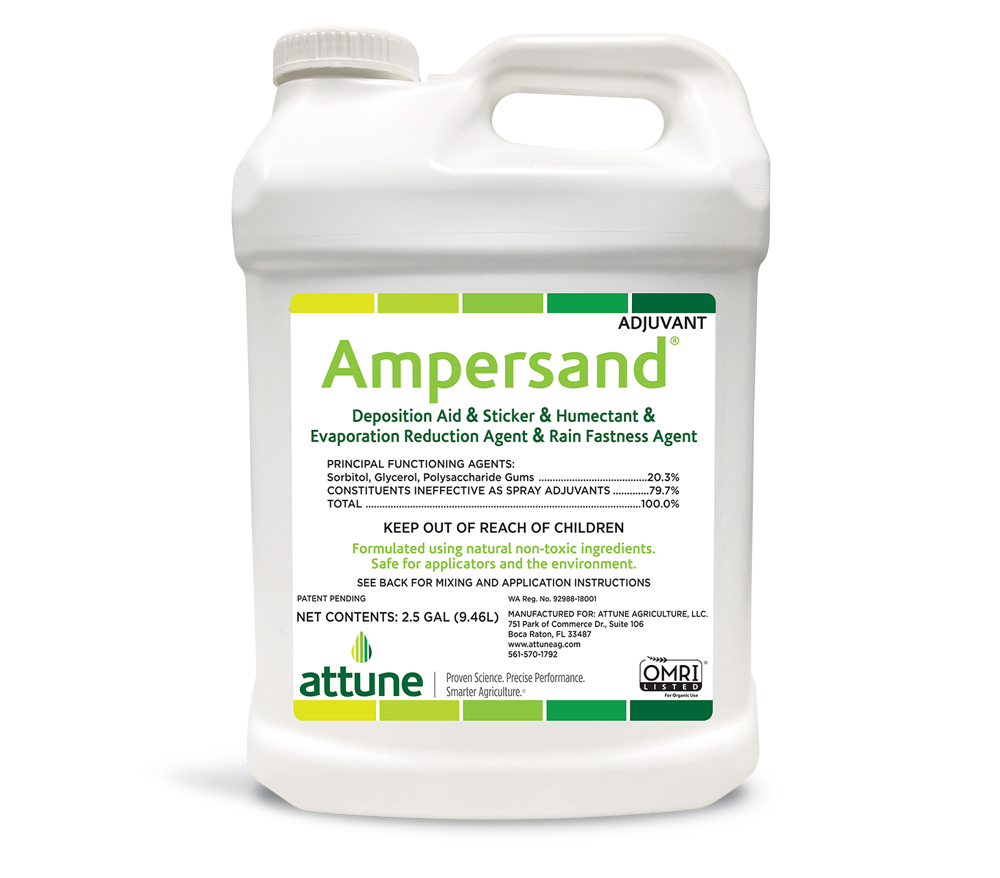Attune Ampersand
Adjuvant system with Drift Control, Deposition Aid, Evaporation Protection, Wash Off Resistance
An adjuvant 100 years in the making

Four-pronged droplet control from the nozzle to the leaf
Reduce Drift
Ampersand’s patented technology starts droplet control at the nozzle. Humectant and hydrocolloid properties regulate droplet size, reducing both fines and large droplets, getting more of your tank mix onto the target.
Increase Deposition
Ingredients that provide adhesion prevent droplets from rolling off the leaf, or bouncing and shattering. Whether it’s horizontal or vertical, droplets adhere securely to the leaf’s surface.
Evaporation Protection
Droplets with high surface tension and a high contact angle keep your active on the target in a liquid state longer, giving systemic and translaminar actives time to perform their functions. Evaporation and drying are concerns of the past.
Wash Off Resistance
Ingredients that provide strength protect droplets from rainfall and overhead irrigation.
Based on studies by Dr. Alan Knight we used Ampersand with sprays of Entrust in our organic codling moth management program in 2019 and had tremendous success in our Jonathan’s. In previous years we have had up to 50% losses to codling moth but in 2019 we brought this down to around 10%.
JAMIE WEYNDLING
Organically farms 100 acres in western Colorado
Proof of Performance
Ampersand’s performance has been validated by extensive testing from leading research facilities across the U.S.
45%
Increased efficacy when combined with sprayable pheromones.
79%
Increased weed control when combined with a leading organic herbicide.
85%
Increased insecticide performance for aphid control.

Details & Labels
Download Labels / SDS
AMPERSAND LABEL U.S.
AMPERSAND LABEL CALIFORNIA
AMPERSAND TECHNICAL BULLETIN
AMPERSAND SDS
AMPERSAND OMRI
Suggested Use Rates
Organic/Conventional insecticides, fungicides, PGR’s, pheromones: 0.125% – 0.25% v/v
Foliar nutrition and micros: 0.125% – 0.25% v/v
Field Notes
Add Ampersand FIRST into the tank as we are treating the volume of water. Water conditioners, such as AMS, can be added before without issue.
DO NOT FREEZE. Ampersand will increase in thickness when very cold or frozen and will be difficult to pour. Optimal temperature is above 45ºF.
Lower water temperatures will require additional mixing to ensure uniform distribution of the product.
USE GUIDE:
No observed phytotoxicity.
Mixes readily with oils in spray solutions.
pH around 3; can help to reduce overall tank pH.
Acts as a partial defoamer when applied to the tank first.
REGULATORY:
100% food grade ingredients used in the formulation.
Toxicology classified as Category IV — no signal words required.
Ampersand is registered for use with herbicides and insecticides in California.
Ampersand is registered for use throughout the U.S.
Frequently Asked Questions
Have you seen any phytotoxicity when using Ampersand/Accomplice?
Ampersand/Accomplice is a highly effective adjuvant that successfully delivers more active ingredient to the leaf. It has been tested extensively alone and with a wide variety of active ingredients and sensitive crops with no phytotoxic effects. That said, if you’re using an active ingredient that is already classified as phytotoxic, you may want to do a small test spray to ensure AMP/ACC is not increasing this effect since it is designed to allow your active ingredient to remain on the plant for 2x longer than other adjuvants.
Are there any known incompatibility issues with Ampersand/Accomplice?
Ampersand/Accomplice has been extensively tested with a broad range of actives without issue. We have found that products that have been highly stabilized with surfactants – like Roundup PowerMax – can cause some slight incompatibilities. We also occasionally find interaction between AMP/ACC and other adjuvants, like drift reduction agents, but those other adjuvants are no longer needed when using AMP/ACC so it’s best for the spray, and for cost, to take those other adjuvants out when using AMP/ACC. The best suggestion is to do a small compatibility test whenever you are trying new combinations of tank mix ingredients to ensure no negative interactions.
